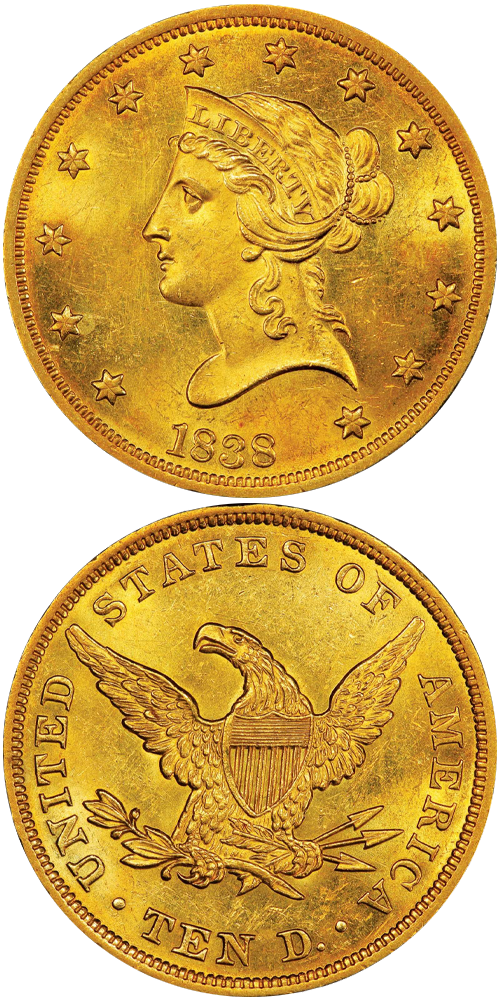1838 Liberty Head Eagle
Before production resumed in 1838, the eagle denomination had not been coined for circulation since the administration of Thomas Jefferson in 1804. A tiny number, probably four or five, were coined in 1834 from newly made 1804-dated dies of the previous design, a Proof-only production that was struck for placement in diplomatic presentation sets like those prepared for the King of Siam and the Sultan of Muscat. On July 27, 1838, Secretary of the Treasury Levi Woodbury informed Mint Director Robert M. Patterson that coinage of eagles was to resume as soon as practicable. "We shall spare no pains to make our chief coin worthy of the Mint," Patterson replied, and Christian Gobrecht was given the task of designing and engraving the new issue of the largest denomination authorized by the Mint Act of 1792.
Another Mint Director, James Ross Snowden, was the first to write about the 1838 eagle from the perspective of a numismatist. "This pattern made its first appearance on the twenty-sixth of December, and consisted of 6,700 eagles (this was the first coinage of this denomination since 1804)," Snowden wrote in 1861. "On the thirty-first of December the Chief Coiner returned to the Treasurer 500 eagles, making 7,200 eagles of the new type issued in this year. This pattern was adopted on the half eagle of 1839, and on the quarter eagle of 1840." The design, what Snowden called a "pattern," was actually heavily modified in 1840, leaving the 1838 eagle as the premier issue of a type that lasted only two years.
The United States Mint would not strike a coin of greater value than the eagle until after the discovery of gold at California's Sutter's Mill. The $20 gold piece or double eagle was the first new denomination authorized since 1792; a gold version of the one-dollar coin would be created by the same legislation. In time, more denominations would be created, including two cents, three cents, twenty cents, and $3 gold pieces. Until gold coinage was proscribed by Executive Order in 1933, eagles continued to be a steadily produced and important denomination. Mintages ebbed and flowed, reaching a high of nearly five million total coins from four different mints in 1881. Eagles were never struck at the two Southern coining facilities that struck exclusively gold coins, Dahlonega and Charlotte, but every other Federal mint produced the denomination.
Though Gobrecht's design was struck with a modified portrait beginning in 1839, and the motto In God We Trust was added to the field above the eagle's head starting with the 1866 issue, the design created for the eagle in the summer and fall of 1838 endured until the 20th century. It spanned from an era when steam power was new to the Mint until the age of automobiles. Eagles struck to the post-1834 New Tenor standard were coined with only two basic designs: Gobrecht's Liberty Head and the Indian Head motif of Augustus Saint-Gaudens.
The watershed nature of the 1838 $10 issue inspires many collectors to seek an example for their cabinet, but nearly all settle for a circulated specimen.
The example to the left was sold by Stack's Bowers Galleries in the D. Brent Pogue Part IV Auction, where it realized $105,750.






